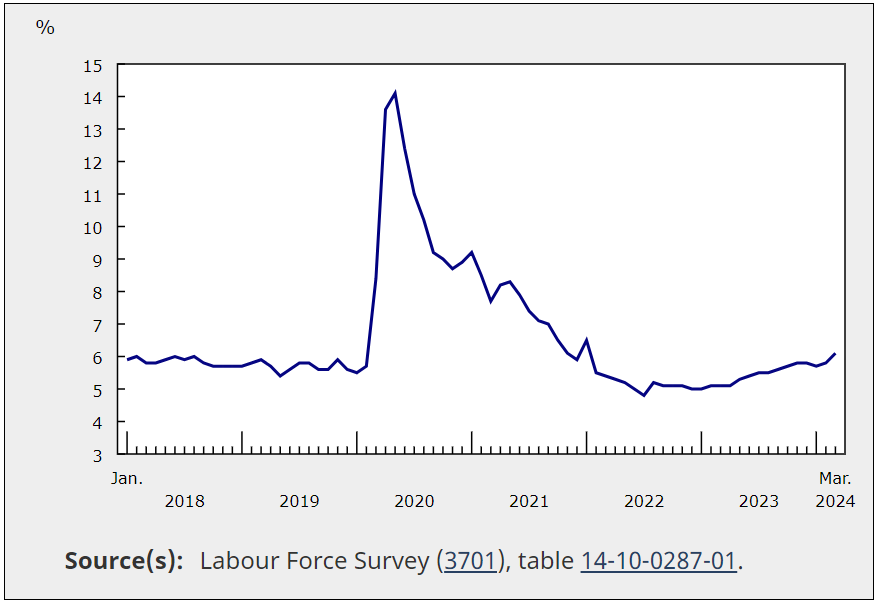Unemployment rate increases, finds latest Labour Force Survey

Employment numbers in Canada dropped slightly in March following increases in the first two months of 2024, according to Statistics Canada (StatCan).
The number of employed workers in Canada dropped by 2,200 last month after it increased by 41,000 (+0.2 per cent) in February and by 37,000 (+0.2 per cent) in January.
The employment rate also dropped to 61.4 per cent, the sixth straight month the rate has fallen.
It was 6.5 per cent in February, according to StatCan.
 Source: Statistics Canada
Source: Statistics Canada
“The soft landing that the Canadian labour market was trending towards to start the year got a bit bumpier in March,” said Brendon Bernard, senior economist at Indeed, in an email to CHRR.
“Employment was flat, even as population growth kept chugging, pushing the unemployment rate above six per cent for the first time in over two years. Hours worked also ticked down, consistent with the weak reading.”
Employment rates for men, women
Employment among youth aged 15 to 24 fell by 28,000 (-1.0%) in March, and their employment rate fell 0.9 percentage points to 55.0% in March 2024, the lowest level since February 2012, – outside of 2020 and 2021, during the COVID-19 pandemic.
The employment rate has trended down for both male and female youth over the past 12 months, falling by 4.8 percentage points to 55.5% for young women in March 2024, and by 4.0 percentage points to 54.6% for young men.
“Among core-aged men, employment rose by 20,000 (+0.3%) in March, following a similar-sized increase in February (+23,000). The employment rate for core-aged men was 87.2% for the third consecutive month, but was down 0.6 percentage points from 12 months earlier,” said StatCan.
“Among core-aged women, employment was virtually unchanged in March 2024, and the employment rate was little changed at 81.3%. The employment rate for core-aged women has generally trended down from the record high of 82.0% observed in both January and March 2023, but remained above the average observed from 2017 to 2019 (79.3%).”
Unemployment rates across Canada
Meanwhile, the unemployment rate upped to 6.1 per cent, the highest since January 2022 when it was 6.5 per cent.
 Source: Statistics Canada
Source: Statistics Canada
“The health of the labour market is divided, between those who already have jobs, and those who don’t. Layoff rates remained lower than historic norms in March,” said Bernard.
“However, the number of new jobs started in the month was far below their seasonal average. As a result, fewer jobless workers were able to find new positions in the month, helping drive the rise in unemployment. It was also another rough month for youth employment.”
Across Canada, the unemployment rate is highest in Newfoundland and Labrador followed by Nunavut. Meanwhile, the rate is lowest in Yukon.
 Source: Statistics Canada
Source: Statistics Canada
Employment gains, losses among sectors
Among sectors, health care and social assistance scored the biggest gains in employment numbers, followed by construction and finance, insurance, real estate, rental and leasing.
Meanwhile, the biggest losers are accommodation and food services and wholesale and retail trade. Professional, scientific and technical services and information, culture and recreation also recorded significant losses.
 Source: Statistics Canada
Source: Statistics Canada
Nearly seven in 10 Canadian employers are hiring entry-level HR professionals in the first half of 2024, according to a recent Robert Half report.




